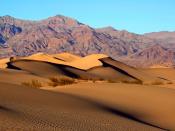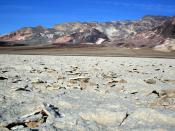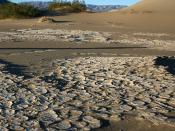Death Valley National Park is the largest National Park in the United States outside of Alaska. Upgraded to National Park status on October 31, 1994, by the Desert Protection act, within its boundaries are some 3.4 million acres of canyons, sand dunes, salt flats, waterfalls, hot springs, 11,000 foot mountains,strange and compelling rock formations, endless vistas, and stars at night that you can almost reach out and touch. The hottest recorded temperature in the Northern hemisphere occurred here near Badwater at 134 degrees F in 1913, ironically the same year the most rainfall occurred (4.54 inches). It is a strange yet breathtakingly beautiful place. It's landscapes are unlike any other.
From July of 1997 to July of 1998, I lived and worked inside the National Park at a resort/village called Stovepipe Wells. It was 129 degrees the day I left, July 17, 1998 ! I moved there to explore the Park, as well as the nearby Owen's Valley area, the Mojave desert to the south, and the surrounding Sierra Nevada Mountains.
While I don't claim to know as much about Death Valley as others, I did get to know the place pretty darn well! This website is intended to give you some information so that you can get the most of your visit there... since the Park is so enormously huge in area, and there is so much to see, it's best to plan ahead so that you don't miss the really cool stuff!
SITES YOU CAN DRIVE TO Many of these sights are concentrated around the Furnace Creek area. You can easily drive to all of them in any passenger vehicle.
VISITORS CENTER Start here. Friendly NPS folks will stear you in the right direction, whether you have 4 hours driving through or want to plan an off road...


